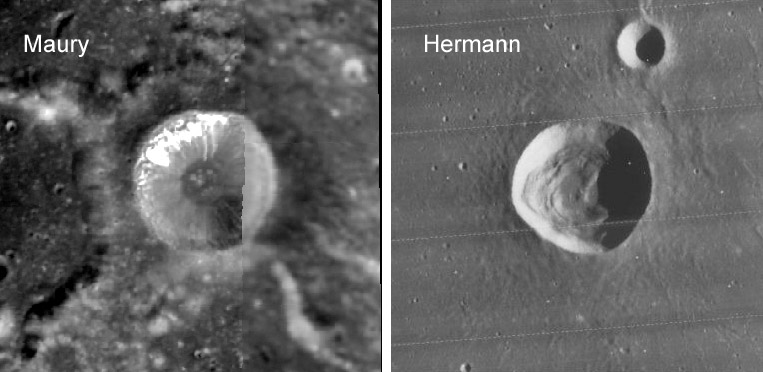
left image of Maury from Clementine at USGS Map-A-Planet and right image from Lunar Orbiter IV-156
Two days ago LPOD looked at small craters with tiny central peaks. Today I saw a new image in The-Moon Wiki of a similar size crater that looks so different that I had to talk about it. Remember the crater Maury (above left)? It is 17 km in diameter and is a simple pit with steep sloping inner walls and a flat floor. Like some larger simple craters it has small central peaks. Hermann is nearly the same diameter - its 15 km across - but looks completely different. The outline of Hermann isn’t quite circular, it is slightly out of round to the west and the south. The reason for the western widening is evident – there is a mass of rim material that has slumped part way down the inner wall – that slippage created a small scallop in the rim. The outer edge of the floor is surrounded by similar slumps; its not clear if the ridge that reaches from the north wall to the middle of the floor is just wall slump material or if it includes a rebounded central peak. There is a pair of numbers that nicely captures the difference between these two nearly identical diameter craters: Maury is 3.3 km deep, and Hermann is 1.7 km deep. Presumably, the two craters looked about the same at the instant of formation – both looked like Maury. But the flowage of wall material onto the floor of Hermann – which might have started just after the crater formed - shallowed the initial pit by 1.6 km. Hermann’s depth is about 11% of its diameter, whereas Maury’s is 19%. This is not just a unique case for these two craters – the depth to diameter ratio systematically gets smaller going from small to larger craters, because of filling of floors by wall material, rebounds of central peaks and widening of diameters by slumping and terracing. And what depressions have the smallest depth to diameter ratios of all? Impact basins: Orientale is about 930 km wide and 6 km deep – its ratio is less than one percent!
Related Links:
Rükl plates 15 & 39
Yesterday's LPOD: Striking Slips
Tomorrow's LPOD: Tell Me a Story
COMMENTS?
Register, Log in, and join in the comments.



